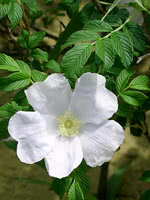Mon-Fri 9am - 5pm Mountain time
Western Snowberry vs White Rugosa Rose
Symphoricarpos occidentalis
Rosa Rugosa alba
NOT AVAILABLE THIS SEASON - MIGHT RETURN
NOT AVAILABLE THIS SEASON - MIGHT RETURN
Like the Common Snowberry, the Western Snowberry is a small shrub with pink flowers useful for feeding livestock and preventing erosion. Unlike the common species, however, the Western Snowberry is much more suited to wet conditions, capable of persevering through poor soil drainage and occasional flooding.
After the Snowberry's flowers have bloomed, it produces berries which often last on the plant through winter. These berries are toxic to humans, but livestock and local wildlife love them! Those hoping to attract wildlife to their property can plant Snowberry and expect to see animals foraging on it much later in the year than other plants.
White Rugosa Rose has many characteristics that will make it both a reliable and beautiful addition to your yard. Tolerant of many conditions and incredibly cold hardy, this rose can withstand salt, poor soil, and wind.
White Rugosa Rose produces white flowers that are attractive and pure white with a papery texture. It will make a great impenetrable hedge or border that is also deer resistant.
Note: This variety is from a seed source, not cuttings. Although somewhat true to seed and color expect some variability.
Western Snowberry Quick Facts
White Rugosa Rose Quick Facts
Toxicity: berries are toxic to humans

